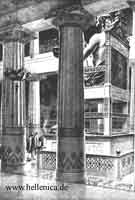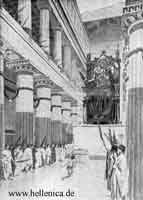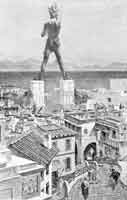.
Der Leuchtturm von Alexandria
Sostratus, the son of Dexiphanes, the Cnidian, dedicated this to the Saviour Gods, on behalf of those who sail the seas.
Dedicatory inscription of the Lighthouse, completed around 280-279 BC.
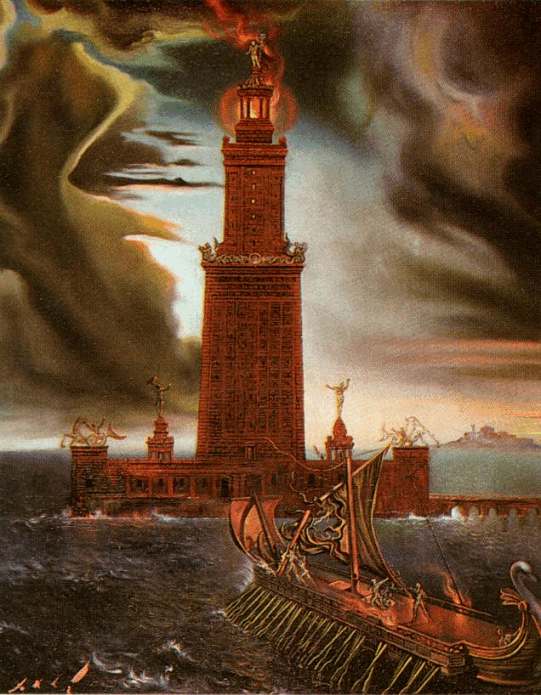
Pharos (Salvador Dali)
Φάρος Αλεξάνδρειας
The first lighthouse of the World, the “Pharos of Alexandria”, lasted for over 1500 years in the harbor of Alexandria. It is one of the 7 Wonders of the Ancient World (different variants exist) some of them described by the poet Antipater of Sidon around 130 BC . The lighthouse of Alexandra was included later replacing the walls of Babylon described in the list of Antipater.
The Pharos was built to warn sailors of the treacherous sandbars off Alexandria, one of the busiest ports of the ancient world. It consisted of a three-stage tower, decorated with sculptures of Greek deities and mythical creatures, atop which stood a lantern with a giant bonfire whose light may have been focused by mirrors, perhaps made of polished bronze, into a beam visible 35 miles out to sea. 300 Slaves worked on the Pharos that was build in 17 years.
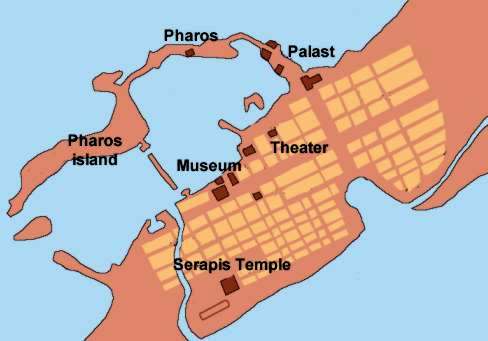
The Pharos on the Pharos island in Alexandria

The Pharos island and the Pharos according to the Natural History Museum, New York and an image today (E. Bauer: Die sieben Weltwunder, p. 130) Alexandria from Space
Ancient accounts such as those by Strabo and Pliny the Elder give us a brief description of the "tower" and the magnificent white marble cover. They tell us how the mysterious mirror could reflect the light tens of kilometers away. Legend says the mirror was also used to detect and burn enemy ships before they could reach the shore. It is said that the light from the top could be seen 30 to 300 miles away! Statius 40-96 AD describes that the light of the Pharos in the night is like that of the Moon. Pliny describes that the light was visible up to 465 kilometers which is impossible except if it would be much larger. Epiphanus writes that the tower was 560 meters. The idea of the lighthouse was adopted by the Romans who constructed also many lighthouses.

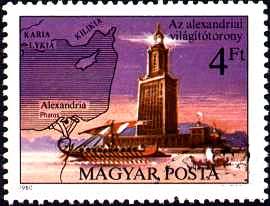
The Pharos of Alexandria in the City founded by Alexander. The left Greek stamp shows a coin that shows probably the construction of the Pharos, Stamps of the Seven Wonders of the World
The Pharos was as an idea of Ptolemy I Soter (367-283/2) BC, but it was build only after his death during the reign of Ptolemy II Philadelphus in the period (284 BC-246 BC). It was designed by the Greek architect Sostratus of Cnidus ( Σώστρατος ), a contemporary of Euclid, but detailed calculations for the structure and its accessories were carried out at the Alexandria Library/Mouseion. The costs for the Pharos: 800 Talents. The monument was dedicated to the Savior Gods: Ptolemy Soter (lit. savior) and his wife Berenice. The lighthouse was still functioning when the Arabs conquered Alexandria in AD 642, but an earthquake damaged the lantern about 50 years later. The Pharos was hit by earthquakes in 1303 and 1323. In 1349 it was in ruins as the Arab traveller Ibn Battuta describes who visited Pharos found it "in such a state of ruin that it was impossible to enter". In 1480 the Egyptian Mamluke Sultan Ashraf Quaitbay built a fort on the site. Certain parts were recuperated and integrated with the fort. But there was little interest, until recently, in knowing more about the main building and the statuary which lay underwater.
One of the descriptions of the Pharos is from 1166 from Abou-Haggag Al-Andaloussi, an Arab traveler who visited the Lighthouse. He documented a wealth of information and gave an accurate description of the structure which helped modern archaeologists reconstruct the monument. It was composed of three stages: The lowest square, 55.9 m high with a cylindrical core; the middle octagonal with a side length of 18.30 m and a height of 27.45 m; and the third circular 7.30 m high. The total height of the building including the foundation base was about 117 m, equivalent to a 40-story modern building. Other sources say that it was even larger, some to even 500 m, but around 120 meters is probably more realistic. At least it was definitely larger than any of the lighthouses that today exist.
The Guiness Book of Records describes the current tallest lighthouse: The steel Marine Tower at Yamashita Park in Yokohama (since 1954), Japan is 106 m (348 ft) high. It has a visibility range of 32 km (20 miles) and an observatory 100 m (328 ft) above the ground.
The internal core was used as a shaft to lift the fuel needed for the fire. At the top stage, the mirror reflected sunlight during the day while fire was used during the night. At the top was an open cupola where a fire burned to provide light. In ancient times, a statue of Poseidon adorned the summit of the building.

Asterix and Cleopatra: Album #6 (Asterix (Orion Paperback)) (Bk. 6)
It was only in the 1990s that the lighthouse resurfaced. While shooting underwater scenes for a film on Hellenistic Alexandria, the Egyptian director Asmaa El-Bakri noticed a concrete dike being built on top of the ruins to protect Fort Quaitbay. A few meters underwater sphinxes and colossal statues of men and women were found. A stone torso of a woman from the third-century BC. X In 1993, when the Egyptian government began building a concrete breakwater around the base of the fortress to protect it from storm damage, there was an outcry from archaeologists who feared the operation might destroy any surviving remains of the Pharos and other nearby ancient buildings. The project was temporarily halted, and scholars from the Egyptian Supreme Council of Antiquities and the French Centre d'Études Alexandrines, led by Jean-Yves Empereur, began searching the waters around the fortress. Begun in 1994 under the direction of Jean-Yves Empereur, head of the Alexandria Study Centre, the mission has thus far classified over 2000 pieces.

The Pharos and Ptolemy II in an Egyptian Stamp from 1998
According to Chris Scarre of Cambridge University, "Their finds confirm that one side of the Pharos collapsed into the sea, and that much material from this amazing structure still lies scattered on the seabed. Only now can we begin to appreciate the true extent and importance of the remains." In addition to the torso, Empereur's team has recovered some 30 other sculptures not from the Pharos, including sphinxes, granite columns and capitals, a fragment of an obelisk with a hieroglyphic inscription, and a headless statue of the pharaoh Ramesses II (ca. 1290-1224 BC).
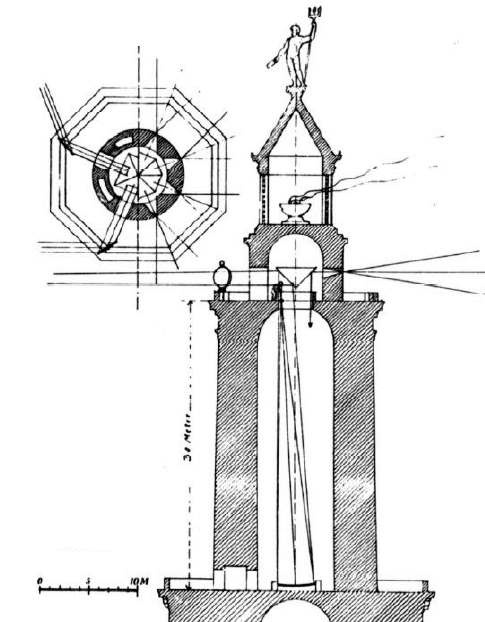
H. Thiersch: Pharos, Antike Islam und Occident – Ein Beitrag zur Architekturgeschichte; B. G. Teubner, Leipzig und Berlin 1909, a German book about the Pharos of Alexandria describing the possibility that it was also used as a telescope. Ibn Khordadhbeh writes in the 9th century AD that one could see even people in Constantinople looking from the telescope of the Pharos.

A 3D reconstuction of the Pharos
The other category of findings consists of much heavier blocks of granite – 49 to 69 tons. The fact that some were broken into two or three pieces indicates that they fell from a great height. Empereur’s team is convinced that these are remnants of the lighthouse. The Pharos was among the tallest man-made buildings until the completion of the Eiffel Tower in Paris in 1889. Only the Pyramids one of the Seven Wonders survived until our times and the last destroyed of these Wonders was the Pharos of Alexandria.
James Abbott:
The light at the top of the tower was produced by a fire, made of such combustibles as would emit the brightest flame. This fire burned slowly through the day, and then was kindled up anew when the sun went down, and was continually replenished through the night with fresh supplies of fuel. In modern times, a much more convenient and economical mode is adopted to produce the requisite illumination. A great blazing lamp burns brilliantly in the center of the lantern of the tower, and all that part of the radiation from the flame which would naturally have beamed upward, or downward, or laterally, or back toward the land, is so turned by a curious system of reflectors and polyzonal lenses, most ingeniously contrived and very exactly adjusted, as to be thrown forward in one broad and thin, but brilliant sheet of light, which shoots out where its radiance is needed, over the surface of the sea. Before these inventions were perfected, far the largest portion of the light emitted by the illumination of light-house towers streamed away wastefully in landward directions, or was lost among the stars.
Of course, the glory of erecting such an edifice as the Pharos of Alexandria, and of maintaining it in the performance of its functions, was very great; the question might, however, very naturally arise whether this glory was justly due to the architect through whose scientific skill the work was actually accomplished, or to the monarch by whose power and resources the architect was sustained. The name of the architect was Sostratus. He was a Greek. The monarch was, as has already been stated, the second Ptolemy, called commonly Ptolemy Philadelphus. Ptolemy ordered that, in completing the tower, a marble tablet should be built into the wall, at a suitable place near the summit, and that a proper inscription should be carved upon it, with his name as the builder of the edifice conspicuous thereon. Sostratus preferred inserting his own name. He accordingly made the tablet and set it in its place. He cut the inscription upon the face of it, in Greek characters, with his own name as the author of the work. He did this secretly, and then covered the face of the tablet with an artificial composition, made with lime, to imitate the natural surface of the stone. On this outer surface he cut a new inscription, in which he inserted the name of the king. In process of time the lime moldered away, the king's inscription disappeared, and his own, which thenceforward continued as long as the building endured, came out to view.
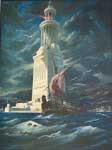
Pharos of Alexandria, Martin Heemskerck
Il Faro di Alessandria - Der Pharos von Alexandria
See also:
Apollo and the Colossal Statue of Zeus in Olympia
The Parthenon and the Acropolis
Proteus and the Island of Pharos
History of Greek and Roman Egypt
The 1900 years old Tower of Hercules
| Ancient Greece
Science, Technology , Medicine , Warfare, , Biographies , Life , Cities/Places/Maps , Arts , Literature , Philosophy ,Olympics, Mythology , History , Images Medieval Greece / Byzantine Empire Science, Technology, Arts, , Warfare , Literature, Biographies, Icons, History Modern Greece Cities, Islands, Regions, Fauna/Flora ,Biographies , History , Warfare, Science/Technology, Literature, Music , Arts , Film/Actors , Sport , Fashion --- |

